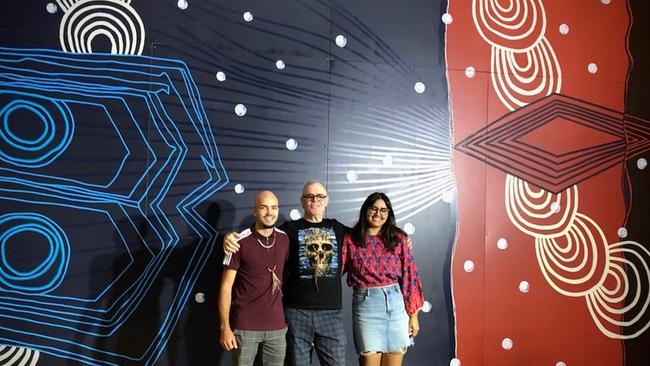Mural cited in Blayney mine rejection made in consultation with dissident Indigenous group
A mural indicating the history of Dreaming stories through Wiradyuri country was made in consultation with the group who would later use it in a bid to shut down the Blayney gold mine.

The artist behind the “blue-banded bee” mural cited by federal Environment Minister Tanya Plibersek to justify her veto of the Blayney goldmine was a member of the main resistance group against the $1bn project, and the local government had never heard of the Dreaming story before the artwork was painted.
The Australian can reveal Brisbane artist Birrunga Wiradyuri, a Wiradyuri man whose mural was used as evidence in Ms Plibersek’s official reasons against the mine, was a regular contributor with the Wiradyuri Traditional Owners Central West Aboriginal Corporation and a member up until at least this August.
The WTOCWAC’s highly disputed claims that the Blayney mine site is a place of historical and spiritual significance to local Aboriginal people are the centre of Ms Plibersek’s moves to kybosh the mine.
Amid deepening questions about the validity of the anti-mine group’s claims, it also can be revealed that the blue-banded bee Dreaming story has not appeared in any of the six ethnographic studies seen by mine owner Regis Resources and there is no public evidence of the story before 2022.
Wiradyuri declared in February 2022 that the mural on the wall of the Bathurst post office was tied to a songline east of the Belubula River. But the Bathurst Regional Council said on Monday it was not aware of the Dreaming story before commissioning the artwork.
“The subject of the art (the blue-banded bee) was developed in partnership with elders during the commission,” a spokesperson said. “Council was not aware of the story prior to this.”
Wiradyuri previously has consulted with WTOCWAC on artworks significant to the Bathurst area, with a February 2022 post on the mural tagging the group, while a June 2022 post gave its “love, esteem respect (sic) and gratitude to the Traditional Owners and Elders of the Bathurst area, the Wiradyuri Traditional Owners Central West Aboriginal Corporation for their counsel and sharing of Cultural Knowledge”.
The WTOCWAC later would cite his artwork in its submissions detailing the blue-banded bee’s longstanding significance to the Blayney site on which the McPhillamys mine was to be established.

In an interview with local newspaper Western Advocate at the time of the artwork’s display, Mr Wiradyuri said he consulted with members of the WTOCWAC in its creation regarding its cultural significance.
“In close consultation with Aunt Wirribee, Uncle Mallyan, Uncle Yanha and Uncle Dinawan (WTOCWAC member and historian Uncle Bill Allen), the story of the bee became an artwork that evolved as we delved deeper into the storytelling process,” he said in an interview.
Documents from the Office of the Registrar of Indigenous Corporations also indicate that Wiradyuri was a member of the WTOCWAC from November 2021 to August this year, a period beginning after the artwork was commissioned until two years past its completion.
As revelations came out about his mural’s role in the decision to veto the mine and his membership of the most prominent local anti-mine group, Mr Wiradyuri was contacted for comment but had not responded by deadline.
Roy Ah-See – one of the most senior Wiradjuri leaders on the national stage and former chairman of the NSW Aboriginal Land Council – has told The Australian elders from the Orange Local Aboriginal Land Council believed the songlines of the blue-banded bee Dreaming “had never previously existed”.
Significant surveys in 2021, including the Philip Clarke Aboriginal Cultural Values Mapping Report, the Lance and Kamminga report and the Sneddon cultural surveys, did not mention the Dreaming.
In her detailed reasons, Ms Plibersek said six members of the OLALC, including five Wiradyuri elders, had disputed the veracity of the blue-banded bee Dreaming in a February submission.
“Information about a public artwork by Wiradjuri artist Baranga Wiradjuri (Birrunga Wiradyuri), named the Blue Banded Bee Creation Story, was also submitted to support the validity of the Dreaming as an Aboriginal tradition,” she said in her report. “Whilst not identical, the description of the artist’s interpretation of the Dreaming is largely consistent with WTOCWAC’s explanation.”
Additional details on the Dreaming story were provided to Ms Plibersek by an unnamed Wiradyuri elder whose submission was delayed due to medical issues.
Mr Wiradyuri began painting in the 2010s, later opening his own gallery in Spring Hill, Brisbane.
He was born Robert Henderson and presented his art under that name until at least August 2018, before going by Birrunga Wiradyuri.
Originally from rural NSW, he has lived in Queensland since primary school, primarily around the Sunshine Coast.
Created in collaboration with Indigenous artists Kane Brunjes and Stevie O’Chin, the artwork’s portrayal and placement on a songline is detailed on Mr Wiradyuri’s gallery website.
“Our sacred mountain is Wahluu (Mount Panorama). There is a sacred songline that runs from Wahluu to Bubay Wahluu (Mount Stewart) and it is this songline that is portrayed in the work,” the caption reads.
“We Wiradyuri, with the counsel and guidance of our Elders, performed a healing ceremony that healed this Songline in 2018. In 2022 the production of the work was housed in Bathurst Memorial Entertainment Centre which is on that Songline.”
In an interview with Bathurst radio station 2BS from February 2022, Wiradyuri said the work “very much sticks to that story (of the blue-banded bee); it’s very close to us Wiradyuri”.
WTOCWAC was contacted for comment and Ms Plibersek declined to elaborate on her detailed reasoning.




To join the conversation, please log in. Don't have an account? Register
Join the conversation, you are commenting as Logout